The iPhone 5 Review
by Anand Lal Shimpi, Brian Klug & Vivek Gowri on October 16, 2012 11:33 AM EST- Posted in
- Smartphones
- Apple
- Mobile
- iPhone 5
GPU Analysis/Performance
Section by Anand Shimpi
Understanding the A6's GPU architecture is a walk in the park compared to what we had to do to get a high level understanding of Swift. The die photos give us a clear indication of the number of GPU cores and the width of the memory interface, while the performance and timing of release fill in the rest of the blanks. Apple has not abandoned driving GPU performance on its smartphones and increased the GPU compute horsepower by 2x. Rather than double up GPU core count, Apple adds a third PowerVR SGX 543 core and runs the three at a higher frequency than in the A5. The result is roughly the same graphics horsepower as the four-core PowerVR SGX 543MP4 in Apple's A5X, but with a smaller die footprint.
As a recap, Imagination Technologies' PowerVR SGX543 GPU core features four USSE2 pipes. Each pipe has a 4-way vector ALU that can crank out 4 multiply-adds per clock, which works out to be 16 MADs per clock or 32 FLOPS. Imagination lets the customer stick multiple 543 cores together, which scales compute performance linearly.
SoC die size however dictates memory interface width, and it's clear that the A6 is significantly smaller in that department than the A5X, which is where we see the only tradeoff in GPU performance: the A6 maintains a 64-bit LPDDR2 interface compared to the 128-bit LPDDR2 interface in the A5X. The tradeoff makes sense given that the A5X has to drive 4.3x the number of pixels that the A6 has to drive in the iPhone 5. At high resolutions, GPU performance quickly becomes memory bandwidth bound. Fortunately for iPhone 5 users, the A6's 64-bit LPDDR2 interface is a good match for the comparatively low 1136 x 640 display resolution. The end result is 3D performance that looks a lot like the new iPad, but in a phone:
| Mobile SoC GPU Comparison | |||||||||||
| Adreno 225 | PowerVR SGX 540 | PowerVR SGX 543MP2 | PowerVR SGX 543MP3 | PowerVR SGX 543MP4 | Mali-400 MP4 | Tegra 3 | |||||
| SIMD Name | - | USSE | USSE2 | USSE2 | USSE2 | Core | Core | ||||
| # of SIMDs | 8 | 4 | 8 | 12 | 16 | 4 + 1 | 12 | ||||
| MADs per SIMD | 4 | 2 | 4 | 4 | 4 | 4 / 2 | 1 | ||||
| Total MADs | 32 | 8 | 32 | 48 | 64 | 18 | 12 | ||||
| GFLOPS @ 200MHz | 12.8 GFLOPS | 3.2 GFLOPS | 12.8 GFLOPS | 19.2 GFLOPS | 25.6 GFLOPS | 7.2 GFLOPS | 4.8 GFLOPS | ||||
We ran through the full GLBenchmark 2.5 suite to get a good idea of GPU performance. The results below are largely unchanged from our iPhone 5 Performance Preview, with the addition of the Motorola RAZR i and RAZR M. I also re-ran the iPad results on iOS 6, although I didn't see major changes there.
We'll start out with the raw theoretical numbers beginning with fill rate:
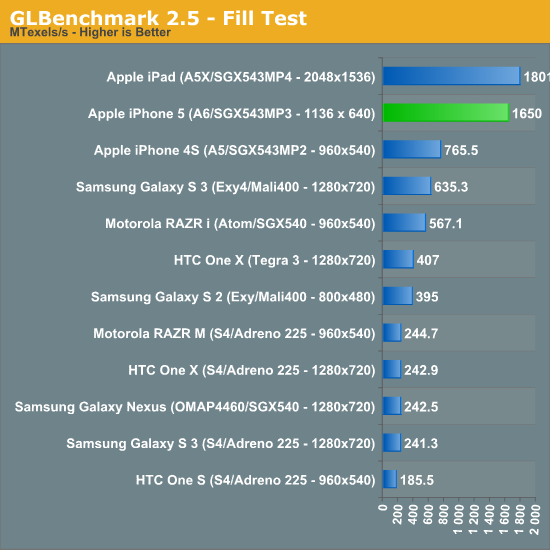
The iPhone 5 nips at the heels of the 3rd generation iPad here, at 1.65GTexels/s. The performance advantage over the iPhone 4S is more than double, and even the Galaxy S 3 can't come close.
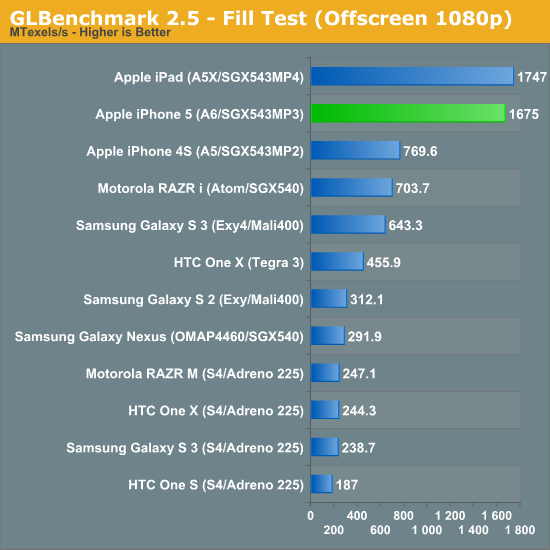
Triangle throughput is similarly strong:

Take resolution into account and the iPhone 5 is actually faster than the new iPad, but normalize for resolution using GLBenchmark's offscreen mode and the A5X and A6 look identical:
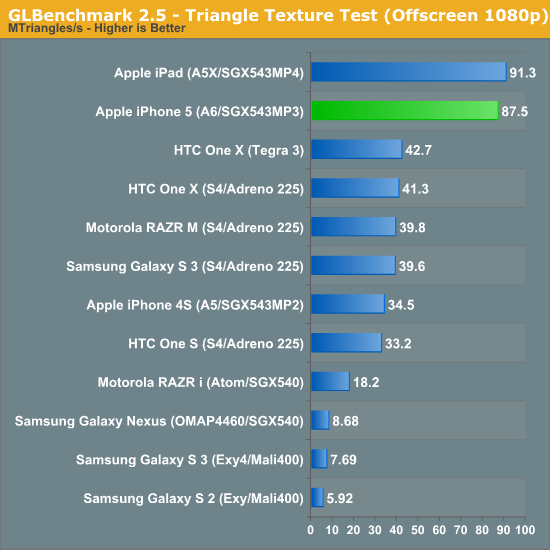
The fragment lit texture test does very well on the iPhone 5, once again when you take into account the much lower resolution of the 5's display performance is significantly better than on the iPad:
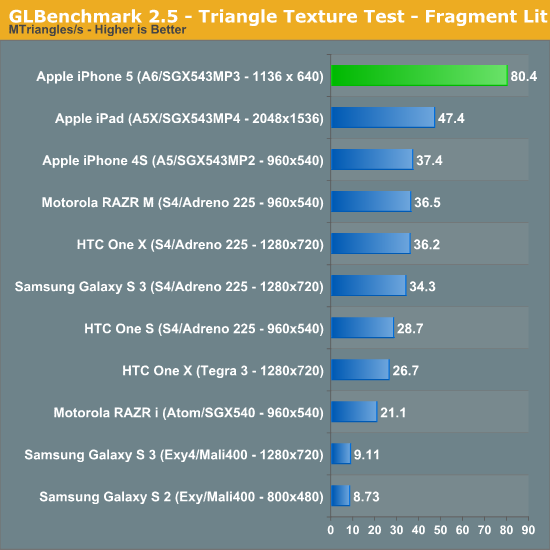
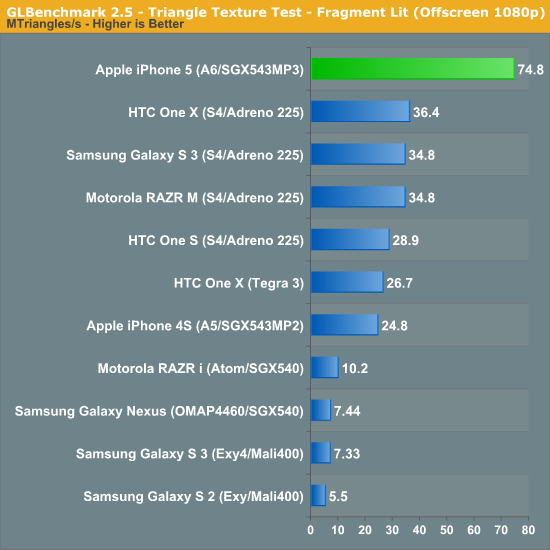

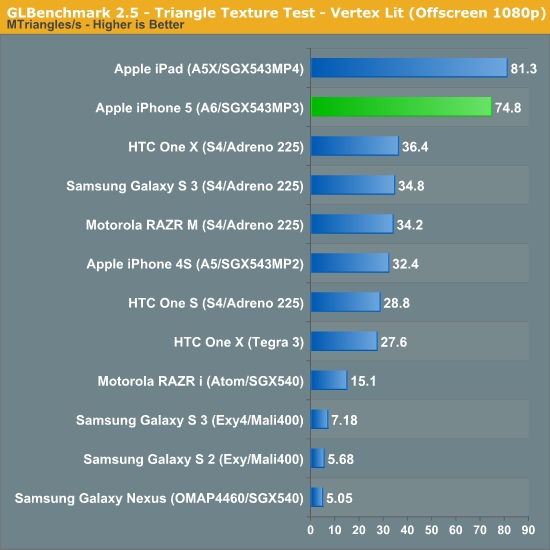
The next set of results are the gameplay simulation tests, which attempt to give you an idea of what game performance based on Kishonti's engine would look like. These tests tend to be compute monsters, so they'll make a great stress test for the iPhone 5's new GPU:
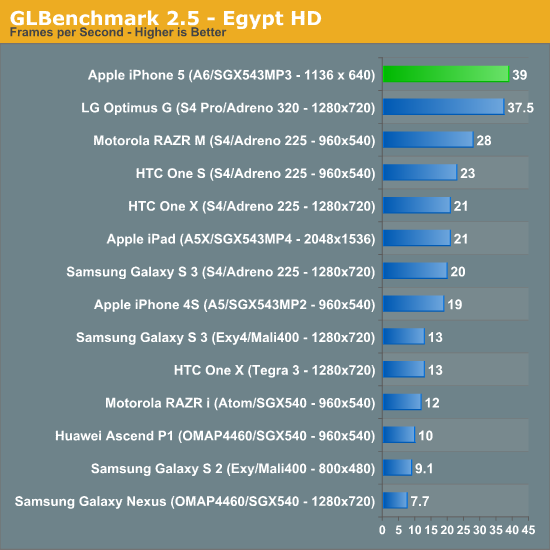
Egypt HD was the great equalizer when we first met it, but the iPhone 5 does very well here. The biggest surprise however is just how well the Qualcomm Snapdragon S4 Pro with Adreno 320 GPU does by comparison. LG's Optimus G, a device Brian flew to Seoul, South Korea to benchmark, is hot on the heels of the new iPhone.
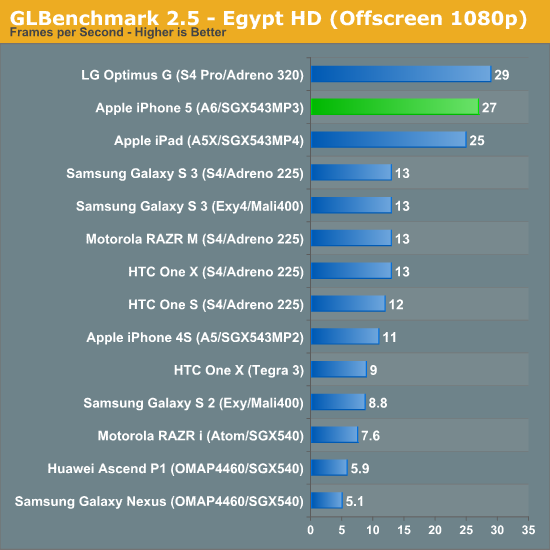
When we run everything at 1080p the iPhone 5 looks a lot like the new iPad, and is about 2x the performance of the Galaxy S 3. Here, LG's Optimus G actually outperforms the iPhone 5! It looks like Qualcomm's Adreno 320 is quite competent in a phone. Note just how bad Intel's Atom Z2460 is, the PowerVR SGX 540 is simply unacceptable for a modern high-end SoC. I hope Intel's slow warming up to integrating fast GPUs on die doesn't plague its mobile SoC lineup for much longer.
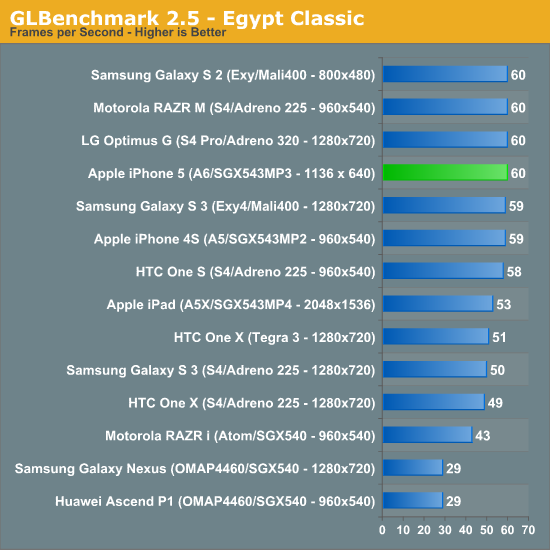
The Egypt classic tests are much lighter workloads and are likely a good indication of the type of performance you can expect from many games today available on the app store. At its native resolution, the iPhone 5 has no problems hitting the 60 fps vsync limit.
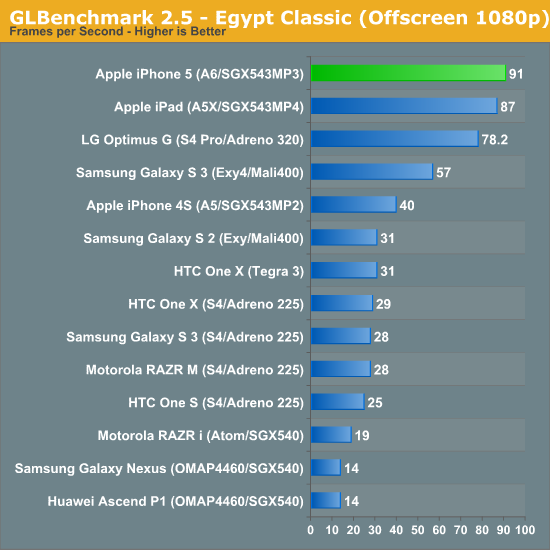
Remove vsync, render at 1080p and you see what the GPUs can really do. Here the iPhone 5 pulls ahead of the Adreno 320 based LG Optimus G and even slightly ahead of the new iPad.
Once again, looking at GLBenchmark's on-screen and offscreen Egypt tests we can get a good idea of how the iPhone 5 measures up to Apple's claims of 2x the GPU performance of the iPhone 4S:
Removing the clearly vsync limited result from the on-screen Egypt Classic test, the iPhone 5 performs about 2.26x the speed of the 4S. If we include that result in the average you're still looking at a 1.95x average. As we've seen in the past, these gains don't typically translate into dramatically higher frame rates in games, but games with better visual quality instead.











276 Comments
View All Comments
youwonder - Wednesday, October 17, 2012 - link
I find it kind of ...odd that the S3 has a much larger battery than the one X and the same SoC yet posts significantly worse LTE browsing numbers, and is the only phone using LTE to get worse results with it than using 3G(granted that is the international vers, doesn't look like they had time to do testing on the AT&T or verizon variant running 3G). Does the samoled screen really draw THAT much more power than an LCD? also there's this which makes me wonder more:http://blogs.which.co.uk/technology/smartphones/be...
Of course, I don't respect these guys as much as anandtech when it comes to accurate results, and they did things much differently (broadcasting their own 3g signal and putting all phones on max brightness), but still the odd results here make me wonder if a small mistake wasn't made.
Zink - Wednesday, October 17, 2012 - link
Max brightness gives the gs3 an advantage because its screen is so dim. The other phones are using LED lighting as well but they go much brighter and have to shine through the LCD panel.youwonder - Wednesday, October 17, 2012 - link
Good point, I guess it's mostly just me wondering why the GS3 LTE variant posts such horrible numbers even compared to it's 3G version when anand specs a good amount of time explaining why the opposite is true.phillyry - Sunday, October 21, 2012 - link
Don't know why but it does tank on LTE.rarson - Wednesday, October 17, 2012 - link
I'm getting so sick and tired of seeing the word "literally" injected into all sorts of sentences that it doesn't belong in. This word only needs to be used when describing something literal. It's not a synonym for "really" (not yet, anyway).andykins - Wednesday, October 17, 2012 - link
Alright, language purist. :Pjoos2000 - Thursday, October 18, 2012 - link
http://theoatmeal.com/comics/literallyphillyry - Sunday, October 21, 2012 - link
Great link. That's too funny - literally!dfonseca - Wednesday, October 17, 2012 - link
On the last page, section "Final Words" / "iPhone 5 Device Conclusions", it's written:> At a high level, the iPhone 5’s cameras appeared to be some of the least unchanged elements of the new device however in practice the improvements are significant.
"Least unchanged" means "most changed." It should probably say "most unchanged," or "least changed."
Nice review, kudos to all authors.
mattlach - Wednesday, October 17, 2012 - link
I had the original iPhone, followed by the iPhone 3G and then the iPhone 4, and just switched to a Samsung Galaxy S3 in July.When the original iPhone came out, while it was the first to do what it did - and that's why I bought it at its steep no-contract introductory price - it wasn't exactly revolutionary, everything in the market was moving in this direction, but it was pretty well executed and nothing else did it at the time.
I upgraded to the 3G on launch, as I thought the edge speeds were dreadful, but was disappointed, as the phone wasn't fast enough to take advantage of 3G, and AT&T's 3G was pretty mediocre anyway. It didn't get important features its competitors had, like copy and paste until very late in the game, and I started to think that I should have gotten an Android phone instead.
By the time I got the iPhone 4, I was tired of my slow 3G experience and just wanted an upgrade to something faster. The iPhone 4 was a good upgrade, but I really only got it because I didn't like AT&T's Android offerings at the time. I had been thinking about going to Verizon and getting an Android for some time. The 3G should have been my last iPhone, it was a mistake to buy the 4.
Having realized my mistake, I waited 2 long years with the 4 until I could finally get out of my AT&T contract and go to Verizon and get a GS3, and it felt great.
The additional freedom of what I run on my phone, not being controlled by Apple and their agenda as to what makes it into the App store, and the fact that I finally no longer had to have iTunes installed on my computer were fantastic.
My computer has been iTunes free for 3 months now, and it feels great!
I was concerned for a while that once the iPhone 5 was released, they would come out with something that would make me regret my choice of the GS3, but it turns out they didn't.
I'll likely never buy anything Apple again. It feels like a huge relief to say that.